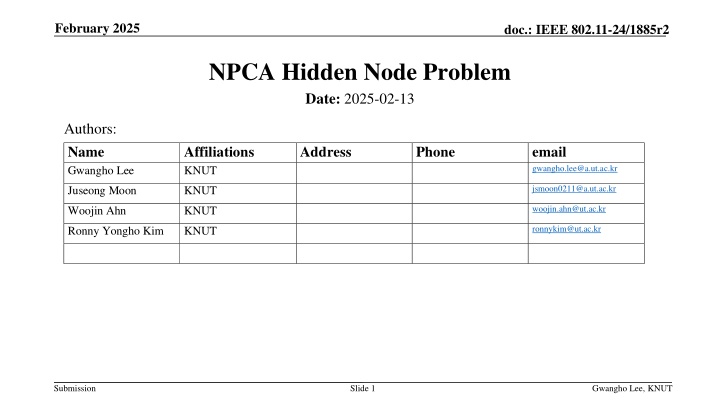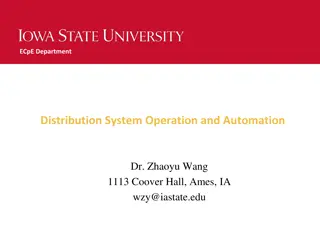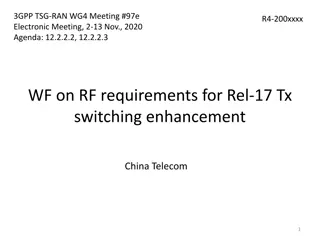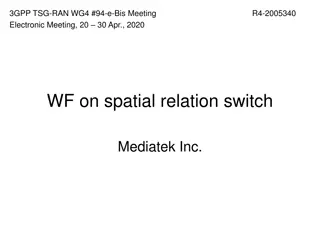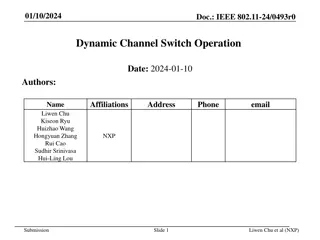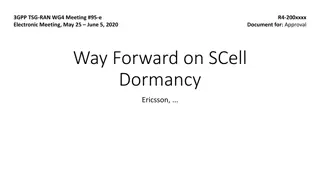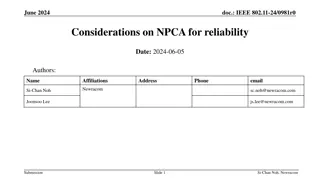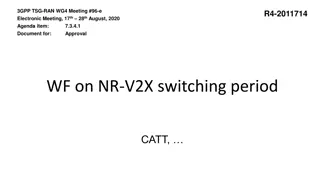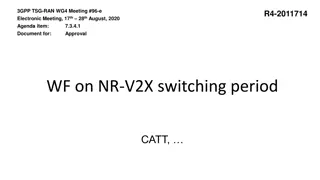Enhancing NCPA Operation for Improved Channel Switching Efficiency
This document discusses modifications to the current NCPA operation to address issues with channel switching efficiency. It focuses on enhancing the Primary Channel Determining Text (PDT) for NCPA, specifically addressing cases where the primary channel is idle but not switched to. The proposed changes aim to optimize NCPA switching conditions and improve overall operation effectiveness.
Download Presentation

Please find below an Image/Link to download the presentation.
The content on the website is provided AS IS for your information and personal use only. It may not be sold, licensed, or shared on other websites without obtaining consent from the author.If you encounter any issues during the download, it is possible that the publisher has removed the file from their server.
You are allowed to download the files provided on this website for personal or commercial use, subject to the condition that they are used lawfully. All files are the property of their respective owners.
The content on the website is provided AS IS for your information and personal use only. It may not be sold, licensed, or shared on other websites without obtaining consent from the author.
E N D
Presentation Transcript
February 2025 doc.: IEEE 802.11-24/1885r2 NPCA Hidden Node Problem Date: 2025-02-13 Authors: Name Gwangho Lee Affiliations KNUT Address Phone email gwangho.lee@a.ut.ac.kr jsmoon0211@a.ut.ac.kr Juseong Moon KNUT Woojin Ahn KNUT woojin.ahn@ut.ac.kr ronnykim@ut.ac.kr Ronny Yongho Kim KNUT Submission Slide 1 Gwangho Lee, KNUT
February 2025 doc.: IEEE 802.11-24/1885r2 Introduction In current PDT for NPCA, several conditions are defined for the NPCA switching operation [1]. With current PDT for NPCA, an NPCA STA may not able to switch to the NPCA primary channel although the NPCA primary channel is idle. In this contribution, to enhance current NPCA operation, a possible modification for the NPCA PDT text will be discussed. Submission Slide 2 Gwangho Lee, KNUT
February 2025 doc.: IEEE 802.11-24/1885r2 NPCA switching in current PDT In the current PDT for NPCA, two conditions are defined for NPCA switching operation. In short: Condition a) an NPCA STA received a PPDU from an OBSS. Condition b) an NPCA STA received a control frame and an initial control response frame from an OBSS. To switch to the NPCA primary channel, the NPCA STA determines whether the NPCA primary channel is idle or not. With the condition b), if the received frames are a (MU-)RTS frame and a CTS frame, the NPCA STA determines the channel occupied by the received frames by examining the (MU-)RTS frame. the text below is condition b) c. in the current PDT. Submission Slide 3 Gwangho Lee, KNUT
February 2025 doc.: IEEE 802.11-24/1885r2 Dynamic Bandwidth Operation for RTS/CTS exchange Meanwhile, in the baseline [2], dynamic bandwidth operation for the RTS/CTS frame exchange is defined. In short, a VHT STA may transmit a CTS frame with same or narrower bandwidth indicated by a RTS frame. Submission Slide 4 Gwangho Lee, KNUT
February 2025 doc.: IEEE 802.11-24/1885r2 Issue with the Current NPCA PDT When the bandwidth used for the CTS frame transmission is narrower than the bandwidth used for the RTS frame transmission, there is a case where NPCA primary channel is idle. However, the current NPCA PDT does not consider such case. Submission Slide 5 Gwangho Lee, KNUT
February 2025 doc.: IEEE 802.11-24/1885r2 Issue with the Current NPCA PDT (cont d) Per the current NPCA PDT, the NPCA STA determines the NPCA primary channel is occupied by the OBSS. In such case, the efficiency of the NPCA operation is degraded. Submission Slide 6 Gwangho Lee, KNUT
February 2025 doc.: IEEE 802.11-24/1885r2 An Enhancement for the current NPCA PDT To enhance the efficiency of NPCA operation, the availability of the NPCA primary channel needs to be determined by examining the bandwidth used for the CTS frame transmission. Submission Slide 7 Gwangho Lee, KNUT
February 2025 doc.: IEEE 802.11-24/1885r2 How to Determine the CTS Frame s Bandwidth In the baseline [2], VHT PHY always checks the scrambling sequence in the received PPDU s SERVICE field. Then the PHY interprets 6th and 7th bits of the scrambling sequence as CH_BANDWIDTH_IN_NON_HT_INDICATOR. CH_BANDWIDTH_IN_NON_HT_INDICATOR may contain bandwidth information through which the received PPDU was transmitted. To indicate MAC of the reception of the PPDU, the PHY issues a PHY- RXSTART.indication primitive that has RXVECTOR parameter list containing CH_BANDWIDTH_IN_NON_HT value. If a frame in the received PPDU has bandwidth signaling TA, the recipient MAC of the frame validates the CH_BANDWIDTH_IN_NON_HT value. If the CH_BANDWIDTH_IN_NON_HT is considered valid, it can be used by the MAC as the bandwidth information for the PPDU. Submission Slide 8 Gwangho Lee, KNUT
February 2025 doc.: IEEE 802.11-24/1885r2 How to Determine the CTS Frame s Bandwidth (cont d) If CH_BANDWIDTH_IN_NON_HT value is received from the PHY, and the NPCA STA can validate it, the NPCA STA can determine the bandwidth of the CTS frame. A couple of conditions should be satisfied in order to utilize the CH_BANDWIDTH_IN_NON_HT value from the CTS frame: The NPCA STA receivesboth the RTS frame and the CTS frame from OBSS. The TA field of the RTS frame is bandwidth signaling TA. Condition 1) Condition 2) Submission Slide 9 Gwangho Lee, KNUT
February 2025 doc.: IEEE 802.11-24/1885r2 Summary In this contribution, an issue with the current NPCA PDT was identified that can degrade the efficiency of NPCA operation. In case of the reception of both RTS and CTS frames from OBSS, if the availability of the NPCA primary channel is determined by only examining RTS frame, there is a case where NPCA operation cannot be performed even though the CTS frame does not occupy the NPCA primary channel. In such case, NPCA opportunity can be wasted. To address the issue above, an enhancement was proposed. The NPCA STA determines the actual bandwidth of the CTS frame transmission. Receiving MAC validates the CH_BANDWIDTH_IN_NON_HT value received from the PHY, and utilize the CH_BANDWIDTH_IN_NON_HT value to check the availability of the NPCA primary channel Submission Slide 10 Gwangho Lee, KNUT
February 2025 doc.: IEEE 802.11-24/1885r2 Straw Poll Do you agree to include the following into the 11bn SFD? When an NPCA STA receives a (MU-)RTS frame and a CTS frame in non-HT (duplicate) PPDU, identification of the channel occupied by received frames is determined by examining the bandwidth of the non-HT (duplicate) PPDU containing the CTS frame Y / N / A Submission Slide 11 Gwangho Lee, KNUT
February 2025 doc.: IEEE 802.11-24/1885r2 References [1] 11-24-1762-23-00bn-pdt-mac-npca [2] IEEE Std 802.11 2020 Submission Slide 12 Gwangho Lee, KNUT
